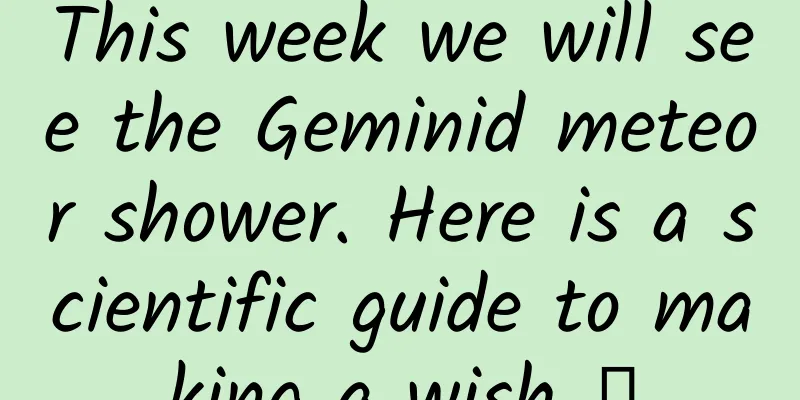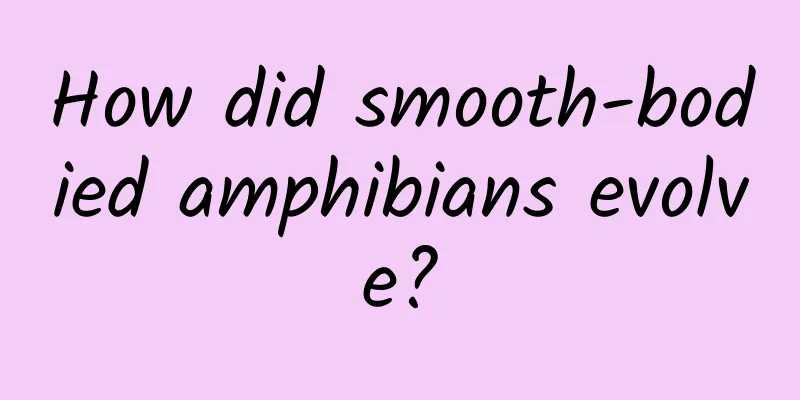This week we will see the Geminid meteor shower. Here is a scientific guide to making a wish →

|
This week, we ushered in the peak of the annual "most trustworthy meteor shower". But I guess many people would say: What’s the concept of keeping one’s word? Why have I never seen it before? In fact, this is because most people have biased expectations about meteor showers. So, what exactly are meteor showers and how can we see them? This article will try to explain it clearly. 01 Meteors: The cosmic "slag" that the Earth encounters Let me give you an example. Imagine a scene in a city. In the middle of the night, a truck loaded with dirt drove into the street. The cover of the cargo box, which should have been sealed, was not closed tightly. The truck bumped and scattered the dirt all over the street. The next morning, the stray cat Xiaobai was walking on the street as usual. The difference was that today Xiaobai stepped on the rubble and got his feet covered in dust. Such a scene is easy to imagine. Next, we will adjust the size of the characters in the scene, and the scene will become a meteor shower. Copyright image, no permission to reprint We magnify the truck carrying garbage and turn it into a comet or asteroid flying through the solar system. Comets and asteroids are relatively loose in texture. When they get close to the sun, the dust, gas and water on their surface will evaporate under the influence of solar radiation and leak into space - just like a truck dropping debris on the street. The stray cat Xiaobai who stepped on the dirt is our Earth. Just as Xiaobai accidentally stepped on the dirt, the Earth, along with all of us, encountered the dust scattered in the solar system by comets and asteroids. The dust and the Earth's atmosphere rub against each other at a speed of tens of kilometers per second, and the kinetic energy is converted into heat energy. The dust is ignited, emitting a dazzling light - this is the meteor we see. There are meteors every day. If you add it up, dozens of tons of dust from all over the world fall to the earth in one day and one night, but we can't see most of them. Occasionally, we can be pleasantly surprised to see some particularly bright meteors, which are called "spontaneous meteors" in astronomy. If the dust is concentrated, we may see multiple meteors coming from "the same truck", which is a meteor shower. 02 Meteor showers: Earth and "trucks" meet every year Unlike sporadic meteors, meteor showers have a fixed cycle. Using the above example, if the “truck” has a fixed route plan, the spilled “soil” will only appear in specific locations. So, only when Xiaobai walks along a specific street at a specific time will he step on the garbage; similarly, the earth will only encounter the "garbage" when it moves to a specific location. The Earth follows a fixed orbit, revolving around the sun once a year, which means that the Earth will repeatedly "step over" a specific location at a fixed time every year, so meteor showers will occur periodically on a yearly basis. There are more than 40 known meteor showers. Among them, there are more than 10 famous meteor showers that contain more bright meteors, also known as "big meteor showers", such as the Perseids, Quadrantids and Geminids, which are known as the "three major meteor showers in the Northern Hemisphere". Each meteor shower is created by a specific comet or asteroid in a specific location, and the dust from these specific locations encounters the Earth at a fixed angle each time. In December alone, there are 9 types of meteor showers. Image source: Screenshot from Star Walk 03 Radiant point and meteor shower name From the perspective of humans on Earth, a particular meteor shower appears in a specific position in the sky. These dust particles enter the Earth's atmosphere at the same angle, and the meteors are parallel to each other, but from our perspective, each meteor seems to come from a specific point in the distance. This point is the radiant point of the meteor shower. You may have had the experience of driving through a tunnel where the markings on both sides of the tunnel are actually parallel but appear to meet at one point in the distance. The same principle applies to meteor showers whose paths are originally parallel but we see them as spreading out from the radiant point. If a meteor in a meteor shower does not appear to come from the radiant point, it means that this meteor is a sporadic meteor. The position and angle at which it enters the Earth's atmosphere have nothing to do with this meteor shower, and its path will naturally not be parallel to this meteor shower. Copyright image, no permission to reprint Astronomers usually name meteor showers after the constellation in which the radiant point is located. For example, the Geminid meteor shower has its radiant point in Gemini, and the Leo meteor shower has its radiant point in Leo. But in fact, meteor showers occur in the Earth's atmosphere and have nothing to do with the constellations in the distant cosmic background. 04 Geminid meteor shower Meteor showers are essentially dust thrown into the Earth's atmosphere by comets and asteroids, and most of the celestial bodies that play the role of "trucks" that scatter "dust" in the meteor showers we can see are comets. Comets carry dust and water vapor from the edge of the solar system to the inner regions of the solar system. But the Geminid meteor shower is quite unique in that the "truck" player is an asteroid - the dust of the Geminid meteor shower comes from the asteroid Phaethon. The origin of Phaethon and the Geminid meteor shower remains a mystery in astronomy. However, for astronomy enthusiasts who want to watch meteor showers, the Geminid meteor shower is very friendly. The time it comes to the earth and the number of meteors it produces are almost the same every year, making it the most stable meteor shower of the year. Therefore, it is called "the most trustworthy meteor shower" by netizens and will not disappoint astronomy enthusiasts who wait for it. 05 Why can't you see meteor showers? This doesn't mean that the Geminids will be easily visible to the general public. To enjoy the meteor shower, some basic observation conditions need to be met, such as sunny days, darkness, and lack of moonlight interference. All these conditions are for one purpose, which is to expose as many fainter meteors as possible so that they can be seen by us. The 2022 Geminid meteor shower will erupt on the night around December 14 and will remain active until December 24. The good news is that around the 14th, when the moon is best for viewing, it will be close to the last quarter and will rise in the east after midnight and be in the southern sky at daybreak, which means there will be no moonlight interference in the first half of the night. As for sunny days, according to the weather forecast of the Central Meteorological Observatory, there is a high hope that most parts of my country will have sunny nights in the near future. Two of the three basic observation conditions have been met, but the last missing condition - "darkness" - is not easy to deal with. The city lights create a “never-sleeping sky” at night, illuminating the sky. Under the brightness of the city lights, we can’t even see the stars. Copyright image, no permission to reprint If you live in an area where it's hard to see lots of stars on a normal night, you're unlikely to be able to enjoy a meteor shower. Only places where densely packed stars can be seen on normal days meet the "dark" conditions for viewing meteor showers. I have made some estimates for you. If the weather is completely clear on the night of the Geminid meteor shower and there is no influence of moonlight, how many meteors can we see in the environment of a big city where a dozen stars can be seen? The answer is: It takes an average of 2 to 3 hours to see one meteor in the entire sky. This is not because there are not enough meteors, but because our environment is too bright. Don't forget what I said above, dozens of tons of dust fall into the earth's atmosphere and become meteors every day and night, but we just can't see them. So, don't wait for shooting stars in the cold wind in the city. If you are in a remote countryside far away from the city, it is still worth trying your luck. You can look at the stars more often this week. Be sure to pay attention to safety and keep warm! Even though you can’t see shooting stars, you can still make a wish, maybe it will come true! What would you wish for? References: [1] Robert Lunsford. Viewing the Geminid Meteor Shower in 2022 [EB/OL] .2022-12-07[2022-12-11]. https://www.imo.net/viewing-the-geminid-meteor-shower-in-2022/ [2] GO Ryabova, The Geminid meteor shower radiant: a mathematical model, Monthly Notices of the Royal Astronomical Society, Volume 507, Issue 3, November 2021, Pages 4481–4486, https://doi.org/10.1093/mnras/stab2286 [3] Wikipedia contributors. 3200 Phaethon[DB/OL]. Wikipedia, The Free Encyclopedia. 2022-12-10[2022-12-11]. https://en.wikipedia.org/wiki/3200_Phaethon Author: Gao Shuang, science writer, PhD in astronomy at Heidelberg University Review | Cheng Cheng Associate Researcher, South American Astronomical Research Center, Chinese Academy of Sciences The cover image and the images in this article are from the copyright library Reproduction of image content is not authorized |
Recommend
Can’t write information flow advertising copy? There is a template here, just use it!
Many friends often complain to me: " Informa...
Do you know these new vegetables?
Iceberg lettuce, kale, chicory, artichokes, cauli...
Case study of making money through SEO of regional websites for confinement nanny and housekeeping services!
As long as you have some experience in making mon...
What should you do if your child’s myopia causes trouble and his eyes “go on strike”?
Dear parents, hello! Nowadays, the speed of techn...
Not "ugly" or "rough", Meizu Blue Note real machine experience
On December 23, Meizu and its new sub-brand Meila...
Why is information flow so popular nowadays? What kind of advertising will dominate the future?
Explore the past, present and future of Internet ...
How to reduce user churn through effective operational activities?
The “Double 12” promotion kicked off the year-end...
The Weird Science and Art Behind Fighting Culture
Leviathan Press: Few people would say that they l...
Disassembling the AARRR model: How to attract 150,000 fans in 10 days at 0 cost?
I believe that many people engaged in operations ...
Can drinking a cup of honey water every day really improve your skin and relieve constipation? Don’t worry, here’s the truth!
In daily life, we often hear various tips for kee...
How to operate content well and create phenomenal products
In my past work experience, I have always been th...
How does information flow advertising highlight selling points? Share 4 tips!
In daily advertising , do our designers and artis...
The French plane tree is not a sycamore and is not native to France.
I heard that the "French plane trees" i...
The battle for platform KOL has entered a hand-to-hand fight! How to create “big V influence”?
What do you think? The KOLs on a platform are mor...
Li Ligang - The secret of wealth for powerful bosses and growing companies
Li Ligang - The secret wealth resource for powerf...









